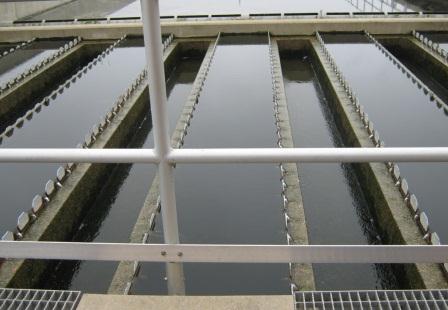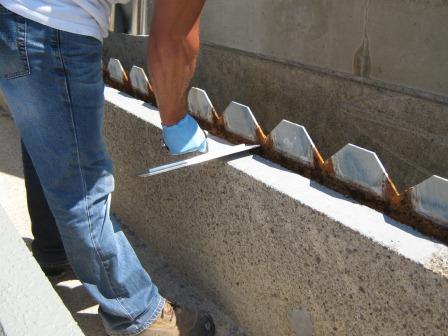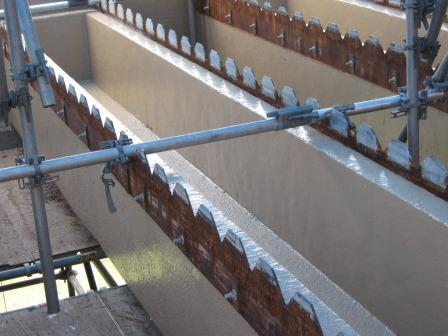The city of Sarnia, known for its petrochemical industry, is home to some 70,000 citizens in Ontario. With one wastewater treatment plant for this Canadian metropolis, it’s no wonder that the concrete on the secondary clarifiers at the Water Pollution Control Centre was pitted and deteriorating. The city decided to coat one of the four secondary tanks as a trial to see if the results were favorable.
 The 13-year-old weirs, which run 24 hours a day, sit outside at the back end of the facility to do the dirty work. These tanks work to clean up the city’s water before sending it back out to the St. Clair River, which runs south from Lake Huron in Michigan to Lake St. Clair in Ontario. Acting as an international border between Canada and the United States, the health of the St. Clair River and, therefore, the proficiency of the treatment plant are vital. The fact that the secondary clarifiers (young, compared to the 50-year-old primary clarifiers) needed repair so badly meant that the plant needed to make some moves quickly.
The 13-year-old weirs, which run 24 hours a day, sit outside at the back end of the facility to do the dirty work. These tanks work to clean up the city’s water before sending it back out to the St. Clair River, which runs south from Lake Huron in Michigan to Lake St. Clair in Ontario. Acting as an international border between Canada and the United States, the health of the St. Clair River and, therefore, the proficiency of the treatment plant are vital. The fact that the secondary clarifiers (young, compared to the 50-year-old primary clarifiers) needed repair so badly meant that the plant needed to make some moves quickly.
Being outside under the elements left the clarifiers covered in algae and debris. This is a particular problem in the summer months, which is when the crew worked on the rehab. That meant, like every other day during the summer, the first thing they had to deal with was getting rid of the increased amount of algae.
“The buildup of algae is terrible in the summertime,” explained Tony D’ Angela, maintenance mechanic for the city of Sarnia. “We have to go out there and [hose them off] every other day because it goes downstream and plugs up other areas of the process.” For the rehab, they started by draining and cleaning the concrete container.
D’Angela power-washed the trial tank with 10,000 psi (68,947.57 kPa). Luckily, for this step it didn’t matter whether they had rain or not. (Although the tanks sit outside, at this point in the rehab process it didn’t matter if extra water was added to the surface already being washed.) However, for the latter stages of the coating, the area would need to be completely dry. D’Angela’s solution was to cover the tank with a tent. As for the crew’s protection? Working around the narrow, trough-like tanks made for a confined workspace. And hovering over the opening of the one being worked on didn’t help either. Therefore, the 250'-long, 33'-wide, 14'-deep (76.20 m x 10.06 m x 4.27 m) tank meant working on scaffolding with harnesses. This crew used Aluma Systems scaffolding and Sala harnesses.
 Once the concrete was dry, D’Angela and his three-man crew conditioned and filled the concrete’s surface. Wearing latex gloves, dust masks, and safety goggles, they filled any pits, cracks, or holes with Belzona 4131 Magma-Screed. They worked quickly in small areas with trowels to offset the heat.
Once the concrete was dry, D’Angela and his three-man crew conditioned and filled the concrete’s surface. Wearing latex gloves, dust masks, and safety goggles, they filled any pits, cracks, or holes with Belzona 4131 Magma-Screed. They worked quickly in small areas with trowels to offset the heat.
“We couldn’t mix a lot at once,” explained D’Angela. “The heat made it set that much quicker, too.” In the 80-to-85-degree F (26.67?29.44° C) weather, the filler needed only about an hour to set. It took about a week and a half to finish all of the troweling. Once it was done, the crew was able to move onto applying the beige coating. They applied Belzona 5811 Immersion Grade barrier in two coats. The first coat was applied with a roller; brushes were used in areas that needed to be cut in. After letting the first coat cure for 24 hours, they returned to apply the second coat in the same manner. The entire application of the barrier coating, which was applied to achieve a total thickness of 20 mils (508 microns), took a week and a half to complete.
Although the coating is also made to be spray-applied, this maintenance crew couldn’t make that happen. “It would have had to go through a heater, and we’re not set up for that,” said D’Angela. It’s nice to know that there are options for the application of this coating. It’s also nice to have a coatings representative to help throughout the process.
 “Frank was there a lot to check in and call,” explained D’Angela of his Belzona technical consultant, Frank Senese. “He was good that way.” Having him around helped make things go smoothly. “As far as putting coating on, it was the first time for us,” said D’Angela, who also has a background in concrete work. For first timers, they seemed to have done a great job. Senese suggested that the final coating sit for seven days before letting the water back in, and when they finally opened up the gates, all seemed well.
“Frank was there a lot to check in and call,” explained D’Angela of his Belzona technical consultant, Frank Senese. “He was good that way.” Having him around helped make things go smoothly. “As far as putting coating on, it was the first time for us,” said D’Angela, who also has a background in concrete work. For first timers, they seemed to have done a great job. Senese suggested that the final coating sit for seven days before letting the water back in, and when they finally opened up the gates, all seemed well.
Senese helped things go quicker, too. Helping get a quarter of the Water Pollution Control Centre’s secondary tanks back in production meant helping out the whole city. “You can’t have more than one tank down at a time,” said D’Angela. “The quicker we got it done the better it was for us for sure.” D’Angela says he would definitely coat the rest of the secondary tanks with Belzona’s system. Hopefully, even though they work directly with the municipality and its budget, that’s exactly what will happen soon. Those other three tanks aren’t getting any younger, after all!